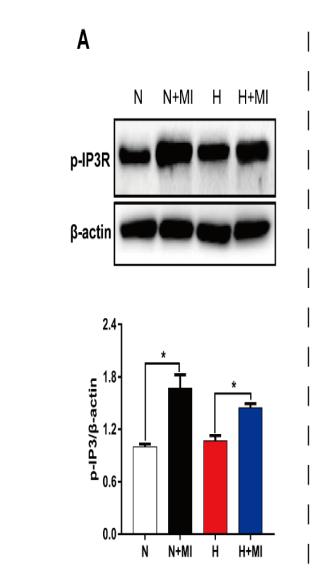Phospho-IP3 Receptor (Ser1756) Antibody - #DF2999
| Product: | Phospho-IP3 Receptor (Ser1756) Antibody |
| Catalog: | DF2999 |
| Description: | Rabbit polyclonal antibody to Phospho-IP3 Receptor (Ser1756) |
| Application: | WB IF/ICC |
| Cited expt.: | WB |
| Reactivity: | Human, Mouse, Rat |
| Mol.Wt.: | 314KD; 314kD(Calculated). |
| Uniprot: | Q14643 |
| RRID: | AB_2840978 |
Product Info
*The optimal dilutions should be determined by the end user. For optimal experimental results, antibody reuse is not recommended.
*Tips:
WB: For western blot detection of denatured protein samples. IHC: For immunohistochemical detection of paraffin sections (IHC-p) or frozen sections (IHC-f) of tissue samples. IF/ICC: For immunofluorescence detection of cell samples. ELISA(peptide): For ELISA detection of antigenic peptide.
Cite Format: Affinity Biosciences Cat# DF2999, RRID:AB_2840978.
Fold/Unfold
4; 5-trisphosphate receptor; 5-trisphosphate receptor type 1; DKFZp313E1334; DKFZp313N1434; inositol 1 4 5 triphosphate receptor type 1; Inositol 1 4 5 trisphosphate Receptor Type 1; Inositol 1; InsP3R1; IP3; IP3 receptor; IP3 receptor isoform 1; IP3R 1; IP3R; IP3R1; ITPR 1; Itpr1; ITPR1_HUMAN; SCA15; SCA16; SCA29; Type 1 inositol 1 4 5 trisphosphate receptor; Type 1 inositol 1; Type 1 InsP3 receptor;
Immunogens
A synthesized peptide derived from RAT IP3 Receptor(P29994) around the phosphorylation site of Ser1756. This site is equivalent to Ser1764 in the human IP3 receptor sequence.
- Q14643 ITPR1_HUMAN:
- Protein BLAST With
- NCBI/
- ExPASy/
- Uniprot
MSDKMSSFLHIGDICSLYAEGSTNGFISTLGLVDDRCVVQPETGDLNNPPKKFRDCLFKLCPMNRYSAQKQFWKAAKPGANSTTDAVLLNKLHHAADLEKKQNETENRKLLGTVIQYGNVIQLLHLKSNKYLTVNKRLPALLEKNAMRVTLDEAGNEGSWFYIQPFYKLRSIGDSVVIGDKVVLNPVNAGQPLHASSHQLVDNPGCNEVNSVNCNTSWKIVLFMKWSDNKDDILKGGDVVRLFHAEQEKFLTCDEHRKKQHVFLRTTGRQSATSATSSKALWEVEVVQHDPCRGGAGYWNSLFRFKHLATGHYLAAEVDPDFEEECLEFQPSVDPDQDASRSRLRNAQEKMVYSLVSVPEGNDISSIFELDPTTLRGGDSLVPRNSYVRLRHLCTNTWVHSTNIPIDKEEEKPVMLKIGTSPVKEDKEAFAIVPVSPAEVRDLDFANDASKVLGSIAGKLEKGTITQNERRSVTKLLEDLVYFVTGGTNSGQDVLEVVFSKPNRERQKLMREQNILKQIFKLLQAPFTDCGDGPMLRLEELGDQRHAPFRHICRLCYRVLRHSQQDYRKNQEYIAKQFGFMQKQIGYDVLAEDTITALLHNNRKLLEKHITAAEIDTFVSLVRKNREPRFLDYLSDLCVSMNKSIPVTQELICKAVLNPTNADILIETKLVLSRFEFEGVSSTGENALEAGEDEEEVWLFWRDSNKEIRSKSVRELAQDAKEGQKEDRDVLSYYRYQLNLFARMCLDRQYLAINEISGQLDVDLILRCMSDENLPYDLRASFCRLMLHMHVDRDPQEQVTPVKYARLWSEIPSEIAIDDYDSSGASKDEIKERFAQTMEFVEEYLRDVVCQRFPFSDKEKNKLTFEVVNLARNLIYFGFYNFSDLLRLTKILLAILDCVHVTTIFPISKMAKGEENKGNNDVEKLKSSNVMRSIHGVGELMTQVVLRGGGFLPMTPMAAAPEGNVKQAEPEKEDIMVMDTKLKIIEILQFILNVRLDYRISCLLCIFKREFDESNSQTSETSSGNSSQEGPSNVPGALDFEHIEEQAEGIFGGSEENTPLDLDDHGGRTFLRVLLHLTMHDYPPLVSGALQLLFRHFSQRQEVLQAFKQVQLLVTSQDVDNYKQIKQDLDQLRSIVEKSELWVYKGQGPDETMDGASGENEHKKTEEGNNKPQKHESTSSYNYRVVKEILIRLSKLCVQESASVRKSRKQQQRLLRNMGAHAVVLELLQIPYEKAEDTKMQEIMRLAHEFLQNFCAGNQQNQALLHKHINLFLNPGILEAVTMQHIFMNNFQLCSEINERVVQHFVHCIETHGRNVQYIKFLQTIVKAEGKFIKKCQDMVMAELVNSGEDVLVFYNDRASFQTLIQMMRSERDRMDENSPLMYHIHLVELLAVCTEGKNVYTEIKCNSLLPLDDIVRVVTHEDCIPEVKIAYINFLNHCYVDTEVEMKEIYTSNHMWKLFENFLVDICRACNNTSDRKHADSILEKYVTEIVMSIVTTFFSSPFSDQSTTLQTRQPVFVQLLQGVFRVYHCNWLMPSQKASVESCIRVLSDVAKSRAIAIPVDLDSQVNNLFLKSHSIVQKTAMNWRLSARNAARRDSVLAASRDYRNIIERLQDIVSALEDRLRPLVQAELSVLVDVLHRPELLFPENTDARRKCESGGFICKLIKHTKQLLEENEEKLCIKVLQTLREMMTKDRGYGEKLISIDELDNAELPPAPDSENATEELEPSPPLRQLEDHKRGEALRQVLVNRYYGNVRPSGRRESLTSFGNGPLSAGGPGKPGGGGGGSGSSSMSRGEMSLAEVQCHLDKEGASNLVIDLIMNASSDRVFHESILLAIALLEGGNTTIQHSFFCRLTEDKKSEKFFKVFYDRMKVAQQEIKATVTVNTSDLGNKKKDDEVDRDAPSRKKAKEPTTQITEEVRDQLLEASAATRKAFTTFRREADPDDHYQPGEGTQATADKAKDDLEMSAVITIMQPILRFLQLLCENHNRDLQNFLRCQNNKTNYNLVCETLQFLDCICGSTTGGLGLLGLYINEKNVALINQTLESLTEYCQGPCHENQNCIATHESNGIDIITALILNDINPLGKKRMDLVLELKNNASKLLLAIMESRHDSENAERILYNMRPKELVEVIKKAYMQGEVEFEDGENGEDGAASPRNVGHNIYILAHQLARHNKELQSMLKPGGQVDGDEALEFYAKHTAQIEIVRLDRTMEQIVFPVPSICEFLTKESKLRIYYTTERDEQGSKINDFFLRSEDLFNEMNWQKKLRAQPVLYWCARNMSFWSSISFNLAVLMNLLVAFFYPFKGVRGGTLEPHWSGLLWTAMLISLAIVIALPKPHGIRALIASTILRLIFSVGLQPTLFLLGAFNVCNKIIFLMSFVGNCGTFTRGYRAMVLDVEFLYHLLYLVICAMGLFVHEFFYSLLLFDLVYREETLLNVIKSVTRNGRSIILTAVLALILVYLFSIVGYLFFKDDFILEVDRLPNETAVPETGESLASEFLFSDVCRVESGENCSSPAPREELVPAEETEQDKEHTCETLLMCIVTVLSHGLRSGGGVGDVLRKPSKEEPLFAARVIYDLLFFFMVIIIVLNLIFGVIIDTFADLRSEKQKKEEILKTTCFICGLERDKFDNKTVTFEEHIKEEHNMWHYLCFIVLVKVKDSTEYTGPESYVAEMIKERNLDWFPRMRAMSLVSSDSEGEQNELRNLQEKLESTMKLVTNLSGQLSELKDQMTEQRKQKQRIGLLGHPPHMNVNPQQPA
Research Backgrounds
Intracellular channel that mediates calcium release from the endoplasmic reticulum following stimulation by inositol 1,4,5-trisphosphate. Involved in the regulation of epithelial secretion of electrolytes and fluid through the interaction with AHCYL1 (By similarity). Plays a role in ER stress-induced apoptosis. Cytoplasmic calcium released from the ER triggers apoptosis by the activation of CaM kinase II, eventually leading to the activation of downstream apoptosis pathways (By similarity).
Phosphorylated on tyrosine residues.
Ubiquitination at multiple lysines targets ITPR1 for proteasomal degradation. Approximately 40% of the ITPR1-associated ubiquitin is monoubiquitin, and polyubiquitins are both 'Lys-48'- and 'Lys-63'-linked (By similarity).
Phosphorylated by cAMP kinase (PKA). Phosphorylation prevents the ligand-induced opening of the calcium channels. Phosphorylation by PKA increases the interaction with inositol 1,4,5-trisphosphate and decreases the interaction with AHCYL1.
Palmitoylated by ZDHHC6 in immune cells, leading to regulate ITPR1 stability and function.
Endoplasmic reticulum membrane>Multi-pass membrane protein. Cytoplasmic vesicle>Secretory vesicle membrane>Multi-pass membrane protein. Cytoplasm>Perinuclear region.
Note: Endoplasmic reticulum and secretory granules (By similarity).
Widely expressed.
The receptor contains a calcium channel in its C-terminal extremity. Its large N-terminal cytoplasmic region has the ligand-binding site in the N-terminus and modulatory sites in the middle portion immediately upstream of the channel region.
Belongs to the InsP3 receptor family.
Research Fields
· Cellular Processes > Cell growth and death > Oocyte meiosis. (View pathway)
· Cellular Processes > Transport and catabolism > Autophagy - animal. (View pathway)
· Cellular Processes > Cell growth and death > Apoptosis. (View pathway)
· Cellular Processes > Cell growth and death > Cellular senescence. (View pathway)
· Cellular Processes > Cellular community - eukaryotes > Gap junction. (View pathway)
· Environmental Information Processing > Signal transduction > Calcium signaling pathway. (View pathway)
· Environmental Information Processing > Signal transduction > cGMP-PKG signaling pathway. (View pathway)
· Environmental Information Processing > Signal transduction > Phosphatidylinositol signaling system.
· Environmental Information Processing > Signal transduction > Apelin signaling pathway. (View pathway)
· Human Diseases > Neurodegenerative diseases > Alzheimer's disease.
· Human Diseases > Neurodegenerative diseases > Huntington's disease.
· Human Diseases > Cancers: Overview > Proteoglycans in cancer.
· Organismal Systems > Circulatory system > Vascular smooth muscle contraction. (View pathway)
· Organismal Systems > Immune system > Platelet activation. (View pathway)
· Organismal Systems > Immune system > NOD-like receptor signaling pathway. (View pathway)
· Organismal Systems > Environmental adaptation > Circadian entrainment.
· Organismal Systems > Nervous system > Long-term potentiation.
· Organismal Systems > Nervous system > Retrograde endocannabinoid signaling. (View pathway)
· Organismal Systems > Nervous system > Glutamatergic synapse.
· Organismal Systems > Nervous system > Cholinergic synapse.
· Organismal Systems > Nervous system > Serotonergic synapse.
· Organismal Systems > Nervous system > Dopaminergic synapse.
· Organismal Systems > Nervous system > Long-term depression.
· Organismal Systems > Sensory system > Inflammatory mediator regulation of TRP channels. (View pathway)
· Organismal Systems > Endocrine system > Estrogen signaling pathway. (View pathway)
· Organismal Systems > Endocrine system > Thyroid hormone synthesis.
· Organismal Systems > Endocrine system > Oxytocin signaling pathway.
· Organismal Systems > Endocrine system > Glucagon signaling pathway.
· Organismal Systems > Endocrine system > Renin secretion.
· Organismal Systems > Endocrine system > Aldosterone synthesis and secretion.
· Organismal Systems > Digestive system > Salivary secretion.
· Organismal Systems > Digestive system > Gastric acid secretion.
· Organismal Systems > Digestive system > Pancreatic secretion.
References
Application: WB Species: Crab Sample: hepatopancreas tissues
Restrictive clause
Affinity Biosciences tests all products strictly. Citations are provided as a resource for additional applications that have not been validated by Affinity Biosciences. Please choose the appropriate format for each application and consult Materials and Methods sections for additional details about the use of any product in these publications.
For Research Use Only.
Not for use in diagnostic or therapeutic procedures. Not for resale. Not for distribution without written consent. Affinity Biosciences will not be held responsible for patent infringement or other violations that may occur with the use of our products. Affinity Biosciences, Affinity Biosciences Logo and all other trademarks are the property of Affinity Biosciences LTD.


